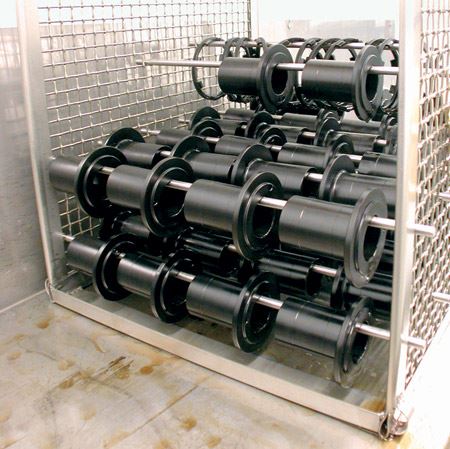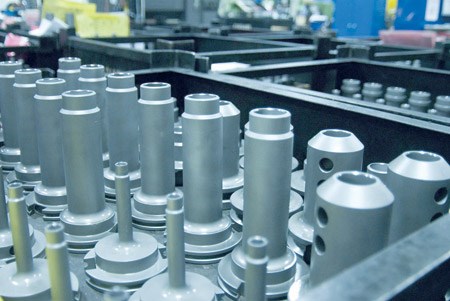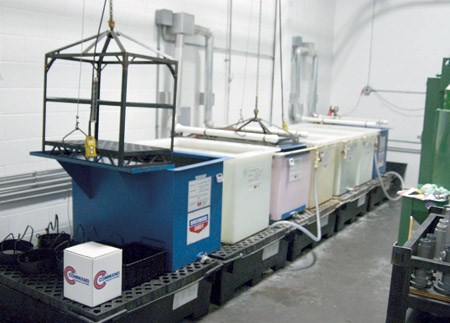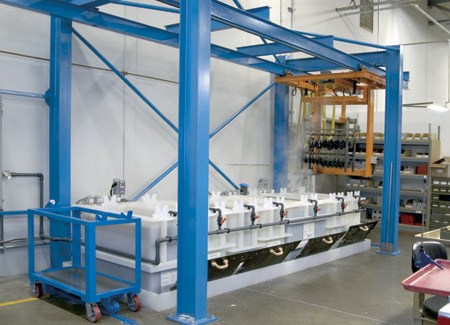Going Lean Has Positive Benefits For Metal Finishing
The rationale behind lean manufacturing applies very directly to metal coating and finishing processes. The cost savings are often greater than one might expect.
In today’s increasingly global marketplace, many manufacturers are adopting lean manufacturing practices in order to optimize quality and costs, thereby gaining a competitive advantage. Whether it’s a formalized lean program or a manager who intuitively streamlines plant operations, every manufacturer is making a concerted effort to improve. The most obvious areas that benefit from lean concepts are the fabricating processes themselves. However, the rationale behind lean manufacturing also applies very directly to metal coating and finishing processes, and the cost savings are often greater than one might expect.
A central element of the lean philosophy is the relentless and systematic elimination of unneeded resources, or waste. The term “waste” can describe several forms of unneeded resources, such as, wasted materials, wasted inventory, wasted motions, wasted energy and more. In short, waste can detract from quality and adds unnecessary costs. Waste is present in many aspects of traditional manufacturing processes. Often very prevalent, it can be a startling awakening for managers once uncovered. This article will examine how adopting innovative metal finishing processes enable manufacturers to eliminate some obvious (and costly) forms of waste in metal finishing operations.
According to the Fabricators and Manufacturers Association, waste in the manufacturing process is: “any element that does not add value, or that the customer is not prepared to pay for”. Put in these terms, it opens the door to examine all aspects of the manufacturing cycle.
From a metal finishing perspective, waste can be present in the following forms:
Excess Inventory—Maintaining excessive inventories of raw materials or finished products adds costs. Every company has different requirements but, ideally, one would want enough raw materials to maintain continuous and smooth work flow through the fabrication cycles, and enough finished products to ensure prompt deliveries to the customer—and no more. Any extra inventory in these areas represents a waste of resources. Inventory that is not either moving, or scheduled to move soon, adds unnecessary costs. From the standpoint of part finishing, sending work out to a plating shop to be coated requires a higher inventory level that supports the turnaround time of the operation. If the turnaround time for outside finishing is five days, then a minimum of five days worth of inventory is needed to support this operation without creating shortages. If any work coming back in is off spec for any reason, more inventory is needed to replace those parts until they are reworked. At first glance, this may not appear to be problematic, but over time, these extra inventory costs add up significantly. The question is how much is this affecting profitability.
Over-Production—Besides raw material and finished inventory, excess in-process inventory is easy to accumulate. In this area, it is useful to examine the optimum lot size in each operation and optimize it to coincide with the customer demand for finished product. Tying production volumes to sales forecasts is an inexact science, but it pays off. Fabricating lot sizes of 100 units may be unwise if you think you’ll sell only 30 finished units in the coming period. It may be more economical to reduce lot sizes and schedule two production runs than it is to schedule one large run. It all depends on the cost to tool up for multiple runs versus the cost of the inventory itself. Another example often used is that of machining a large enough run of parts in order to beat the minimum charge at the plating shop. This lot size may be far larger than your sales department can sell in a reasonable period. In this area, there are benefits to be gained from an in-house low temp black oxide line that allows one to efficiently finish parts in smaller lots that coincide better with the sales cycles.
Over-Processing—This area focuses on the prospect of excessive handling and processing during the manufacturing cycle. Is each operation necessary? Can the workflow be streamlined by eliminating certain operations or changing the order in which they take place? Can the vendor be enlisted to provide raw materials in a condition that eliminates operations? Can paperwork be eliminated? Receiving reports, in-process documentation, shipping requisitions, purchase orders and many more paper documents can often be replaced by digital or computerized data. Similarly, paper trails can often be eliminated or minimized by changing the nature of the process they support. Shipping parts to an outside vendor requires purchase orders, shipping documents, receiving reports, inventory adjustment documents, etc. This is in addition to the work itself. Anything that eliminates unnecessary operations or paper trails has the potential to reduce costs. An in-house black oxide line can often eliminate large portions of the paper trails that go along with sending work outside for finishing. For example, every load of parts that goes to the plater requires a purchase order, shipping requisition, inventory adjustment tag, bill of lading, transportation to the plater, transportation back from the plater, receiving ticket, inventory re-adjustment tag, invoice from the plater and payment, invoice from the carrier and payment—and perhaps more. This might occur several times per week. An in-house black oxide line can eliminate most or all of this paper, along with the turnaround time of sending work out.
Scrap and Rework—Scrap/rework can be very costly to every company. Each operation must be examined, and perhaps re-configured, to optimize its initial quality and minimize rejects. Outside processing can be a huge source of off-spec work because it can be outside the limits of normal quality inspections. Even good shops drop a part occasionally or damage it along the way. Your chances of minimizing these losses are best when you carry them out within your own plant. This includes the coating and finishing operations. When parts require re-machining, it is much easier to re-blacken the parts if you have your own system on site. In these cases, the re-blackening requires an additional 30 minutes rather than an additional five days.
Transportation—Freight costs are rising every year, due to fuel costs and additional regulatory costs. Consequently, it makes sense to minimize the number of shipments used, when possible. Shipping in-process parts to the plater for finishing, then shipping them back, adds costs. For small lots of parts, the freight can sometimes be worth more than the coating services being performed. Any use of in-house operations can minimize or eliminate these costly freight charges.
Waiting—Delays in the manufacturing cycle because of built-in wait periods can add costs in many ways. Waiting for outside finishing work to come back in may mean that other operations must be postponed. Or, it may even require that available labor forces are put on hold, or shifted to other projects in order to keep them busy. Since labor is usually the largest single cost element in manufacturing, any make-work operations are an inefficient use of resources. In contrast, if operations within the plant contain built-in waiting periods, there is an opportunity to schedule these in a way that takes advantage of these wait periods by allowing the operator to do other jobs while waiting. These idle workers can often be re-deployed to perform other tasks. For example, one machine operator can often tend two manufacturing cells, alternating between both during the dwell or waiting periods of each operation. For example, he can operate an in-house black oxide line during the waiting periods of a CNC machining center cell.
Motion—Excess movement of parts during processing also adds unnecessary costs. This is the rationale behind manufacturing cells. Anything that can be done to minimize unneeded movement of parts across the plant floor, into and out of storage during the production cycle will reduce costs. When examining the metal finishing aspects of fabricating, many manufacturers have benefited from locating an in-house black oxide cell right next to a machining cell. The work can be off-loaded from the machining centers directly to black oxide racks and processed immediately, often by the same operator. The parts are then discharged directly to assembly or packaging in a finished condition.
Underutilized Workers—Since labor is often the largest single cost element in manufacturing, it makes sense to efficiently use the talent that is available, as long as it can be done safely. Most manufacturers are focusing hard on cross-training their employees so they can backfill into other departments when needed. This is very smart use of talent. The days of “that’s not my job” are rapidly disappearing—and rightly so. Most employees are smart enough to learn more than one job, but they must be motivated and willing to contribute their talent toward multiple tasks for the good of the company. Of course, some jobs are best performed by a single highly-trained person who is efficient enough to turn out a high volume of work. The balance point depends on the manager to recognize the relative benefits of versatile multi-job capability versus the more efficient single-job performance. In the metal finishing area, it is often common to see a single operator working two cells—a screw machine or bead blast cell on one side of the aisle and an in-house black oxide cell on the other side. Since both processes entail certain dwell times that must be observed, the operator often has a chance to alternate back and forth operating both systems at high efficiency levels. In this way, an in-house low-temp black oxide system can often be installed without raising labor costs significantly.
Using Automation Rather Than Live Labor—Most manufacturers are working hard to automate every aspect of their production in order to minimize labor costs and stay competitive. The smart use of CNC machining and other automated fabrication machines has eliminated a great deal of unneeded labor costs. This same rationale can be applied to metal coating and finishing operations. An in-house low-temp black oxide system can easily be automated to the point at which it literally requires zero labor cost to operate. These process lines utilize a programmable hoist (similar to a CNC control) that moves the part loads from one black oxide station to another automatically, without requiring human labor input. The automated black oxide machine picks up racks of raw parts and automatically delivers racks of black oxided parts.
Here’s the scenario: the operator from the department just previous to black oxide (machining, deburring, heat-treat, etc.) offloads parts directly to the black oxide racks, then wheels the loaded racks into the pickup queue for the black oxide line located nearby. Once the loaded rack is in place, the black oxide machine recognizes that it’s ready, then picks it up and begins the black oxide process. The black oxide hoist is programmed with all the appropriate movements and dwell times needed to process the part loads through the various stations of the black oxide process. The hoist can be programmed to support up to three part loads that begin the process sequentially every ten minutes. Since the black oxide process usually takes about 30 minutes total, these loads actually run concurrently, each one in a different phase of the operation. In this way, the hoist automatically overlaps dwell times and wait periods to eliminate dead spots in the program. Consequently, the hoist is seldom idle. When the parts have completed the black oxide cycle, the finished load is placed into an unload station. From this point, the operator from the assembly department will wheel the load over to his cell and begin final inspection and assembly operations. In this way, the automatic black oxide process has performed a vital and necessary function without the use of human labor or the possibility of human error. No additional inventory is needed because the parts move smoothly through the black oxide operation on their way to inspection/assembly. These automatic black oxide machines can be built to accommodate any volume of parts, often at a cost that is much lower than that of a CNC machining center.
With these points in mind, it is easy to see how in-house black oxide can benefit the lean program in many different ways, leading to improvements in quality and reductions in cost.
Read Next
The Cut Scene: The Finer Details of Large-Format Machining
Small details and features can have an outsized impact on large parts, such as Barbco’s collapsible utility drill head.
Read More3 Mistakes That Cause CNC Programs to Fail
Despite enhancements to manufacturing technology, there are still issues today that can cause programs to fail. These failures can cause lost time, scrapped parts, damaged machines and even injured operators.
Read More











.png;maxWidth=300;quality=90)
















